




Corporate and Operating Measures
adjusted earnings per share
In 1997 we set ourselves the goal of increasing adjusted earnings per share at a double-digit rate. Adjusted earnings measures the underlying earnings performance of the business and excludes certain non-cash items, notably goodwill amortisation and non-recurring items such as the cost of integrating substantial acquisitions. During the previous three years we also excluded the exceptional level of internet investment from the calculation. We hit our target in each of the first four years but last year we did not. Adjusted earnings per share were 29% lower than in the year 2000 – at 22.5p – after recognising all internet losses.


In 2002, earnings performance will be assisted by a steep reduction in
internet losses and the benefit of cost reductions we have achieved over
the past 12 months, while in 2003 we should experience some cyclical recovery
in advertising and technology markets, alongside a higher level of investment
in US public education. Looking further out, we will benefit from our
leading positions in growing markets and our ability to share assets and
processes. Set against this, inflation is at a lower level than in 1997,
much of the margin improvement which we planned at that time has now been
achieved, and the rate of taxation on our US profits will rise in the
years ahead.
ebitda
Changes in the accounting treatment of financial items such as goodwill amortisation and deferred taxation have made it more difficult to discern the underlying operating performance of the business and to make meaningful year on year comparisons. EBITDA (earnings before interest, tax, depreciation and amortisation) is the best measure we can find of the underlying profitability of our businesses. It is a close proxy for operating cash flow, although the numbers themselves are derived from the profit & loss statement.


EBITDA is widely used in the stock market to measure business performance
and is also a reference point for bankers and bond investors in determining
the credit status of a borrower. Last year the reduction in losses from
our internet enterprises broadly offset the impact of very tough markets
on our non-internet operating income to leave total EBITDA little changed
from the previous year at £588m. The strong growth in EBITDA shown for
previous years results from both underlying growth in profitability and
the strengthening of the group through acquisition.
free cash flow
Free cash flow per share is a measure of the cash which is freely available, after the payment of interest and tax, for distribution in the form of dividends and for reinvestment in the business. The proceeds of disposals and the cost of acquisitions, together with any substantial integration costs associated with them, are excluded from the calculation. Pearson’s total free cash flow has been depressed over the past several years by a high level of investment demands, on our print businesses as well as on the internet. We believe that these investments will help us to sustain a higher rate of sales growth in the future but we also need to ensure that dividends to shareholders are paid from the cash generated by the business.
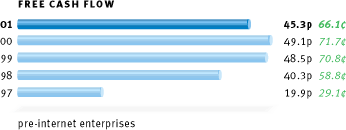

Free cash flow in any one year may be affected by individual investment
programmes or by the timing of routine cash receipts and disbursements.
But it is important that this measure of performance shows an improving
trend over a period of years. In 2001 total free cash flow per share was
29.6p per share, covering the year’s dividend in cash terms, and we expect
a further improvement in free cash flow generation this year. We expect
free cash flow to become more strongly positive in 2003.
underlying sales growth
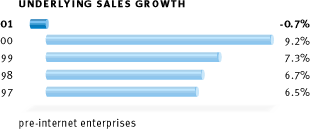
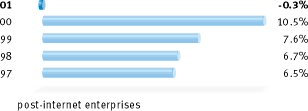
The acceleration of sales growth has been a central strand of Pearson’s
strategy over the past five years. Internal investment and a balanced
programme of acquisitions and disposals have both helped to stimulate
the underlying growth rate of the company. Last year, for the first time,
these efforts were not rewarded with success as the falling demand in
our more cyclical markets offset progress elsewhere to leave the underlying
level of sales very slightly below the level of the previous year.
In order to calculate underlying sales growth we exclude the impact of acquisitions and disposals on the one hand and of currency movements on the other. Uncertainties about the timing of the recovery in cyclical markets make us cautious about a return to strong underlying growth in the year ahead although we believe that the leading positions we have now achieved in each of our three businesses will help us to gain share from our competitors whatever the economic climate.
trading margin
The trading margin measures our ability to turn sales into profit. Last year, as it became clear that sales growth would fall short of our budgeted expectations, we took action to reduce first our variable costs, such as marketing and investment in new projects, and then our infrastructure costs, including our salary bill. This inevitably meant a reduction in numbers of people employed although we achieved this wherever possible without recourse to compulsory redundancy programmes. These cost initiatives mitigated the impact on operating profit of the shortfall in sales, although margins still came under pressure, in part because the cost reduction measures themselves cost money to implement.

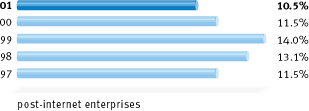
We expect to achieve a recovery in trading margins this year, because
we will see the benefit for the full year of the actions taken in 2001
to reduce costs. Our objective is to ensure that Pearson Education, Penguin
and the FT Group all achieve ‘best in class’ margins in their respective
industries. We believe that this objective was achieved in 2001 and should
be realised again this year.
cash conversion
Our newspaper businesses typically convert almost all of their operating profit into operating cash flow but, if they are to grow, our book publishing businesses need to absorb capital – in the form of authors’ advances, pre-publication costs, inventory and receivables. We do not, as a result, seek to convert 100% of our operating profit into cash, although we have set ourselves a minimum target of 80% cash conversion for any year. We achieved that target again last year, as exceptionally strong cash collection in the closing weeks of the year pushed the conversion rate to just above 90%.
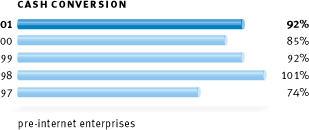
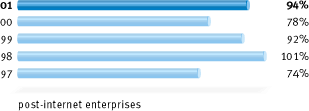
The profile of Pearson’s cash flow is highly seasonal, with a large proportion
of the cash generated, by the education company in particular, being realised
in the closing months of the year. We are placing increasing emphasis
on the management of this seasonality with the goal of reducing average
levels of capital employed in the business during the year. We have launched
a major new drive within Pearson to achieve this goal and it has been
reflected in bonus targets for the senior management of our book publishing
companies.
| Top of Page |